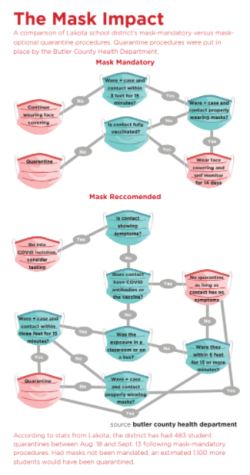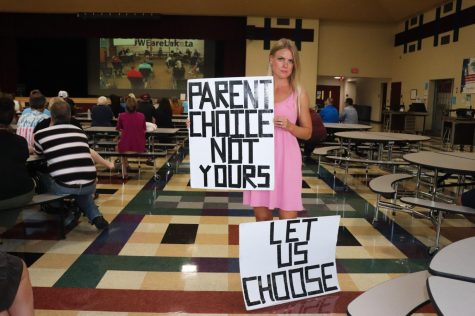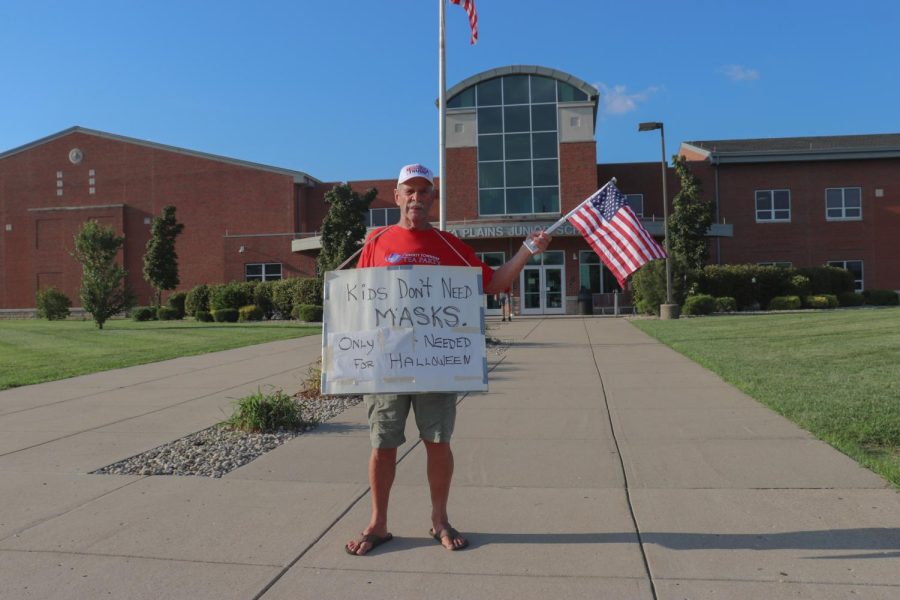STORY, PHOTOGRAPHY AND INFOGRAPHIC MARY BARONE
Nearly 200 concerned parents and community members cram into the dimly-lit cafeteria of Plains Junior. A broadcast of the Lakota School Board meeting in a nearby classroom is projected over the stage. All eyes glued on the screen, the charged-up crowd erupt with cheers or boos as the board discusses the recently-announced mask mandate.
Following Superintendent Matt Miller’s announcement on Aug. 16 that masks would be required for Lakota students and staff during the 2021-2022 school year, debate surrounding mandat ed masking spread throughout the community.
ed masking spread throughout the community.
THE DECISION
On Aug. 16, 2021, Lakota Superintendent Matt Miller announced that the district would require masks for all in-person students and staff during the 2021-2022 school year. The announcement was delivered by email two days before students returned to school on Aug. 18, 2021.
“The information that we are receiving is changing, almost daily,” Miller told Spark. “The piece of information that pushed me over the edge in terms of mandating masks was the letter from 350 [Southwest Ohio] doctors and that came in two days before we announced our decision.”
As superintendent, Miller has the authority to make emergency decisions on the daily operations of Lakota schools without seeking the board’s approval first. This authority includes his decision to require face masks instead of strongly recommending them shortly prior to the start of school.
On Aug. 5, the district issued a survey to Lakota staff, parents, and students via email enquiring whether they felt masks should be required in the upcoming school year. Of the 7,700 surveyed, 49% voted no and 45% voted yes. A third of those who voted yes thought that masks should only be mandated for grades K-6, and two-thirds voted for mandatory masks among all students and staff.
When issuing the survey, the district clarified that it was one data point among several that would be taken into consideration, and the decision would not be made based on the results. Miller was not surprised by the community’s mixed reactions to the mandate.
“The speakers at our board meetings, emails [we have received], and the [staff and parent] survey all seem to be 50-50 now,” Miller said. “Some people understand and some people don’t. I have emphasized that this is more about keeping kids in school rather than masks or no masks because it comes down to quarantines.”
According to Miller, the Lakota Board of Education has been looking towards mask-optional districts to predict the results if Lakota were to do the same. For instance, Hamilton County Schools’ percentage of positive COVID-19 cases is three times Lakota’s and Princeton’s is six. Additionally, Mason City Schools requires K-6 students to wear masks and their positive rate is 3.5 times more than Lakota.
“We’re educators, not public health experts,” Miller said. “These decisions are made based on facts and observing the consequences that non-[mask] mandatory districts deal with.”
QUARANTINES
According to the Lakota website, in the first semester of the 2020-2021 school year, 5,493 quarantines were issued to students and staff due to COVID-19 exposure. The quarantine process, determined by the Butler County Health Department and the Ohio Department of Health, takes in a variety of factors including vaccination status, the proper wearing of masks, and distance between students.
“If everyone is masked in a classroom setting and someone tests positive, no one has to be quarantined,” Executive Director of Community Relations Betsy Fuller told Spark. “The procedures get messy when masks are not mandated, so we had to take that into consideration.”
The district will be required to comply with House Bill 244 starting Oct. 1, 2020. Due to the Delta-8 variant, schools will no longer be able to take vaccination status into consideration when issuing quarantines. Released on July 27, 2021, this state legislation follows the Center for Disease Control’s updated guide for students to wear masks in close-contact public places, even if they are fully vaccinated.
Fuller explained that while this bill lessens the divide between vaccinated and unvaccinated students, it also ensures a higher number of quarantines if students do not wear masks at all times.
Refusal to wear a mask properly will result in a case of insubordination according to Lakota’s website. However, students may still be exempt from wearing a mask for a medical or religious reason. The district has a two page waiver that the student’s parent must fill out to qualify for exemption. As of Aug. 20 the district has received 119 mask waivers for the entire district, meaning .68% of the student population is dismissed from wearing a mask.
 COMMUNITY RESPONSE
COMMUNITY RESPONSE
East’s demographic reflected the community’s mixed feelings towards the mandate. In a recent Spark survey of168 East students, 49% of students believe masks should be mandatory compared to the other 51% who do not. Additionally, 56% of students surveyed feel safer in schools with mandated masks and only 29% of students wear masks in public places where they are not required.
East senior August Whitton falls under the 49% of students in support of the mandate.
“It’s not that big of a deal to wear a mask in my opinion. They’re pretty inexpensive, and you only wear them for a few hours of the day,” Whitton told Spark. “I was in-person and wore a mask all year. I’m used to it at this point.”
Upon hearing of the mandate, Woodland parent Alisia Davis was disappointed by the district’s decision to announce it at the last minute. Davis says that she would have made arrangements for her son to attend a mask-optional private school if she had more warning.
“[The district] took the opportunity from us to make another decision,” Davis told Spark. “It felt very strategic and spineless, and that’s what pissed me off the most.”
Following the announcement, Davis and her husband created an online petition titled “nomasklakota”. As of Sept. 16, the petition had accumulated more than 1,058 signatures. The site also urged parents to attend a 9am protest at the Lakota Local School District Offices, proclaiming that children have the right to say “Our Body, Our Choice” to the mask mandate.
The protests lasted three days: the first took place on Aug. 17 with an attendance of over 70 community members. They held up anti-mask signs to cars driving by: they read things such as ‘parent choice not yours’ and ‘let us choose’. Protests went on for four days with each protest consisting of less participants than the last.
BOARD RULING
On Aug. 23 the school board met at Plains Jr. to discuss the topic of mandatory masks. 161 parents and community members showed up to speak on the topic, 12 of whom were masked.
Board Member Lynda O’Connor motioned to strongly encourage masks rather than enforce them, but was not seconded in her request. O’Connor then motioned for the board to reconsider the mandate at its meeting on Sept. 27.
“There’s absolutely no clear path, but I still move toward parent choice in the process,” O’Connor said. “Parents need to be able to make decisions for their children’s health and we have moved away from that.”
The board passed O’Connor’s amended motion unanimously after board member Julie Schaffer emphasized the impact that unmasked students have on others.
“When one child comes in unmasked and brings in COVID based on their parent’s decision, it impacts another child and whether they get COVID,” Schaffer said. “We are not operating in individual biomes, we are operating together.”
Lakota Board Member Brad Lovell acknowledged all sides of the argument, but reminded the community of the board’s main priority.
“The core competency of this district is to educate children. We’re not trying to be divisive; what we’re trying to do is keep our children in school so they can learn,” Lovell said. “I want the masks to go away too, but right now they’re necessary for us to carry out our responsibility as a district.”







































































































